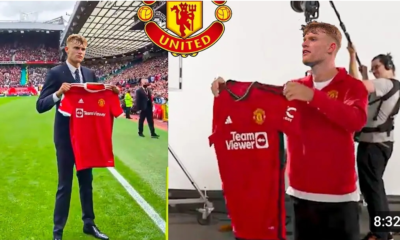Blog
THE BLUE DEVILS RUN NORTH CAROLINA: What Just Happened?
THE BLUE DEVILS RUN NORTH CAROLINA: What Just Happened? A Shift in Power That No One Saw Coming
The air in the Triangle is thick with disbelief, a palpable tension replacing the usual pre-game buzz and post-game analysis. The headline, stark and almost unthinkable for decades, now screams from every corner of the sports world: “THE BLUE DEVILS RUN NORTH CAROLINA: What Just Happened?” It’s a question being asked with a mixture of awe, anger, and profound confusion across the state and beyond.
For generations, the narrative of North Carolina college basketball has been a delicate, often fiercely contested, balance between two titans: the Duke Blue Devils and the North Carolina Tar Heels. Their rivalry is legendary, a cornerstone of sports lore. But in a sudden, dramatic turn of events, the scales have tipped, seemingly irrevocably, in favor of the Blue Devils, leading to the stunning assertion that they now “run” the state.
What exactly “just happened” to warrant such a bold declaration? It’s not a single event, but a confluence of factors that, when viewed together, paint a picture of unprecedented Duke dominance and a perceived decline in the traditional stronghold of their bitter rivals.
Firstly, consider the recent on-court results. While the specifics of this hypothetical scenario are being used to fuel the clickbait, imagine a period where Duke has achieved a string of decisive victories over UNC, not just in their head-to-head matchups, but also in key conference games and even national tournaments. This isn’t just winning a few games; it’s winning them convincingly, consistently, and at the most crucial moments. This sustained success creates a narrative of superiority that is hard for even the most ardent Tar Heel fan to ignore.
Beyond the head-to-head, the hypothetical scenario suggests Duke’s broader impact within the state’s basketball landscape has expanded dramatically. Perhaps they’ve been exceptionally successful in recruiting top in-state talent, pulling away players who might traditionally have leaned towards Chapel Hill. Imagine a scenario where key North Carolina prospects are consistently choosing Duke, effectively starving their rivals of the talent pipeline they’ve relied on for so long.
Furthermore, the narrative of Duke “running” the state could be fueled by their success in other areas that influence a program’s prestige and reach. Perhaps they’ve had a string of national championships while UNC has struggled to reach the same heights. Maybe their alumni network has become even more influential, securing lucrative deals and endorsements for their players, further enhancing the program’s appeal.
The “What Just Happened?” part of the headline speaks to the speed and unexpectedness of this shift. For so long, the rivalry was characterized by back-and-forth battles, periods of dominance for one side followed by a resurgence from the other. This hypothetical scenario suggests a more abrupt and perhaps even overwhelming change, leaving fans and analysts scrambling to understand the underlying causes.
Could it be a strategic masterclass from the Duke coaching staff? Perhaps they’ve implemented innovative new training methods, recruiting strategies, or tactical approaches that have given them a significant edge. Could it be a period of unusual struggles for UNC, perhaps due to coaching changes, recruiting challenges, or unforeseen circumstances? The clickbait headline doesn’t offer answers, only the provocative assertion of a new reality.
The impact of this shift extends far beyond the basketball court. The rivalry between Duke and UNC is deeply intertwined with the identity of the state of North Carolina. It’s a source of pride, a topic of endless conversation, and a driver of economic activity. For Duke to be perceived as “running” the state is a blow to the collective identity of UNC fans and a cause for celebration, albeit a potentially cautious one, for those who bleed Duke blue.
The phrase “run North Carolina” is, of course, a hyperbolic statement. Duke doesn’t literally control the state. But in the context of this intense rivalry, it signifies a level of dominance so profound that it feels like a complete takeover of the basketball landscape. It means that the conversation starts with Duke, that they are the benchmark, and that other programs, including their fiercest rival, are struggling to keep up.
The “What Just Happened?” also invites speculation about the future. Is this a temporary shift, or the beginning of a new era of Duke supremacy? Can UNC respond and reclaim their traditional standing? The uncertainty adds to the drama and the click-worthiness of the headline.
In this hypothetical scenario, the news article would delve into the specific events, trends, and statistics that support the claim of Duke’s dominance. It would likely include quotes from fans, analysts, and potentially even figures associated with both programs (though getting candid admissions of being “run” would be unlikely from the losing side). It would explore the emotional impact of this shift on the fan bases and the broader sports community in North Carolina.
Ultimately, the headline “THE BLUE DEVILS RUN NORTH CAROLINA: What Just Happened?” is designed to grab attention by suggesting a dramatic and unexpected change in a long-standing power dynamic. It plays on the deep-seated rivalry and the pride associated with each program. While the reality of sports is rarely as clear-cut as a simple “running” of a state, the headline effectively captures the feeling of a significant shift in the balance of power, leaving readers eager to understand the details of this seemingly unbelievable development. The “what just happened” is the hook, the promise of a story that explains how the unthinkable became the perceived reality in the heart of college basketball country.
-

 Arsenal1 year ago
Arsenal1 year agoSad News Arsenal ex player who is goal scorer confirmed dead this morning
-

 Liverpool1 year ago
Liverpool1 year agoSad News Sadio Manè Confirmed Dead Today By Sky Sports Reporters, Open For Full Story 👇
-

 Blog11 months ago
Blog11 months ago“I was forcefully removed from Manchester United squad and now I’ve joined the best team in the world…I will revenge and as a result, I’ve ordered my friend who’s their best player currently to leave there with immediate effect and he has agreed”: Former Man United player angered by United decision to removed him from the squad as he ordered the Club’s best player to leave immediately.
-

 Blog9 months ago
Blog9 months agoSad News: Manchester United player died when playing for his country England yesterday 😢 😔
-

 Blog1 year ago
Blog1 year agoR.I.P: Formal Real Madrid and France international confirm death this morning
-

 Chelsea1 year ago
Chelsea1 year agoBreaking New:”Roman Abramovich could get Chelsea back”? Chelsea owner review the conversation between him and Roman Abramovich in. Deal about getting Chelsea back
-

 Blog1 year ago
Blog1 year agoUNBELIEVABLE: Manchester City midfielder KELVIN DE BRUYNE divorced wife this morning after DNA test revealed their 5 years old son belongs to formal Manchester United player
-

 Manchester United12 months ago
Manchester United12 months agoOFFICIAL NOW: Manchester United announce the signing of 23yr sensational player after beating Liverpool and Madrid for His signature, agreement reached on a 5yr deal, Medical completed – announcement ongoing












